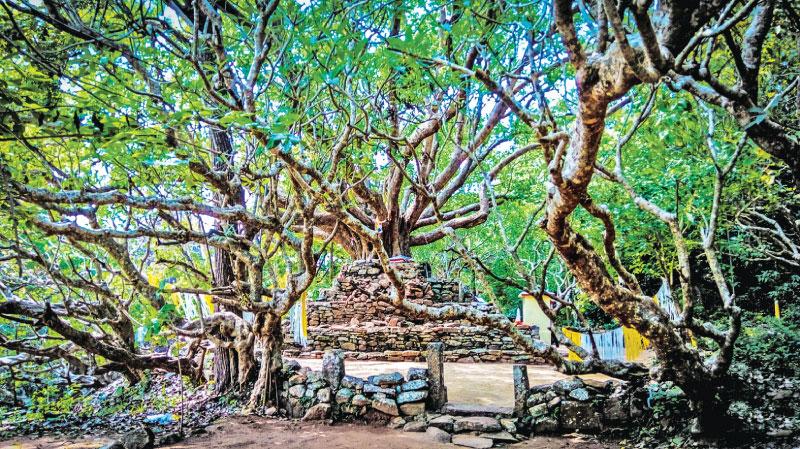
Sasseruwa lies in the forest of Kudakathnoruwa, Meegalewa on the Kurunegala-Anuradhapura border off Galgamua (Wannihathpattuwa)in the Mahaweli H scheme.
The history of Ras Vehera dates back to over 2,100 years to the time of King Devanampiyatissa who built Sasseruwa.
The temple of Sasseruwa is also known as Ras Vehera. Legend has it that Sasseruwa was given this name as Budu Ras (the Buddha’s halo) had appeared (emanated) when one of the 32 saplings of the Sacred Bo Tree, (the Jaya Sri Maha Bodhiya) was planted here by King Devanampiyatissa.
 |
| The Sasseruwa Buddha Statue |
Some historians say that King Walagambahu (BC 104 - BC 103 / BC 89 –BC 76) stayed here to escape foreign invaders. During this time, he also gathered troops and accordingly, this jungle temple was known as Senega ras karapu viharaya (the temple where troops were gathered). So, some say that the name Ras Vehera came from the words Senega ras karapu viharaya. King Walagambahu is credited with having built the Len Viharayas or cave temples.
One of the reasons for this jungle temple’s popularity is the Buddha statue commissioned by King Dhathusena (455-473 AD).
This is somewhat like the famed Avukana statue near the Kalawewa in the North Central Province also commissioned by King Dhathusena and which is 14 kilo metres away from Sasseruwa.
Legends
There are many stories and legends linking these two statues. One story is that King Dhathusena originally commissioned a stone mason to create statute of standing Buddha cut from rock on the hillside.
The King had doubts about the strength of the rock at Sasseruwa and asked the mason to stop work and sculpt a statue at Avukana where the stone was stronger.
 |
| The Avukana Buddha Statue |
The stone mason was so in love with the work he was doing that he did not want to stop. He sent a pupil, (some say it was a brother) to sculpt the Avukana statue. Another legend says that the two statues were the result of a competition between a Master and his pupil. The master is supposed to have sculpted the statue at Avukana while the pupil is thought to have done the one at Sasseruwa.
They had agreed that whoever finished first should ring a bell so that the other would know that the statue was finished. The master finished his statue at Avukana first and rang the bell. The pupil at Sasseruwa heard it and knew that he had lost the contest. He was disgusted and stopped working on the statue. Some people say that this is why the Sasseruwa statue is incomplete. A third legend is about two brothers who were stone masons. The elder brother was carving an image of a standing Buddha at Sasseruwa and got Barana, the younger brother to help him. But soon, Barana stopped following his brother’s instructions and did as he pleased. This made the elder brother so angry that he chased Barana away. An angry Barana came to Avukana and carved the beautiful statue at Avukana.
Differences
Though both the Sasseruwa and Aukana statues look similar, there are several differences. The Sasseruwa statue is slightly smaller. It is said to be 36 feet in height while the Avukana statue is said to be 46 feet. However, figures differ in different sources.
The Avukana statue is complete in every detail while the Sasseruwa statue is not. It has no siraspatha (halo around the head) and one ear is unfinished. The final touches to the robes are not complete and the statue stands on an undecorated square block. The hand of the Sasseruwa statue is in the Abhaya Mudra while the hand of the Avukana statue is in the Asissa Mudra.
The Avukana statue is virtually separate from the rock, but the Sasseruwa is more connected to the rock (high-relief).
The jungle temple of Sasseruwa is spread over 1,400 acres on a rocky out crop. In ancient days, there is supposed to have been 99 drip ledge caves but only nine can be seen today. Many steps lead to the massive standing Buddha statue on the upper level of the rocky hill. A Dharma Shalawa built in the style of Kandyan architectural design and a bubble shaped dagoba are close to the stairway.
The Maha Viharaya lies inside a drip ledge cave. There is a large statue of a reclining Buddha and an unusual feature of this statue is that a cotton robe had been draped on it before the plastering was done. Remnants of the robe can be seen even today. Paintings of Jataka Stories decorate the walls and the ceiling decorated with the defeat of Mara (death) by the Buddha. An ancient and massive Bo tree surrounded by a Bodhigara (protective wall) can be seen half way down the stairway.
A Makara Thorana (dragon arch) stands at the entrance to the image house which houses nine Buddha statues of varying size. Outside this are found ancient inscription and protective drip ledges.
According to archaeologists, the statue at Sasseruwa is the first and the oldest statue built in the Maha Vihara tradition in Sri Lanka.
